Across the globe around 100,000 people die of snake bites every year and another 250,000 are permanently disabled. Even though snakes are considered as dangerous reptiles, there are a large number of non- venomous snakes around the world which are of negligible harm to humans. Most of the snakes are shiny, elegant and beautiful. These creatures with no legs and flickering tongue play a vital role in natural environment and food webs. Snakes have highly-developed senses of sight, taste, hearing, and touch, which make these cold blooded creatures effective hunters and ambush predators. Conservation of snakes is crucial to maintain balance in the food web. Here are the top 10 species of snakes that are non-poisonous
1. Anaconda
Anacondas are the one of the biggest snakes in the world. Their average size is 6 m (20 feet)long and 148 kg(300 pounds) . Anacondas make their home in the Amazon Jungles of South America. Generally they live in rivers and swamps. When confronted with danger they prefer to escape through the water than attacking. They prey on animals like frogs and toads, fish, birds, ducks and turtles . Their style of hunting is similar to that of a Python.
2. Python
The Pythonidae is commonly known as python. Pythons are large muscular snakes which grow up to 35 feet and weigh as much as 300 pounds. Pythons are well known for the way they kill their pray by squeezing then to death and then swallowing them all at once. Pythons have been known to kill and eat animals as large as pigs and cats. Pythons are also kept as pets , but some incidents suggest it unsafe. These cold blooded murderers are found in Asia, Australia and sub-Saharan Africa.
Most members of this family are ambush predators, in that they typically remain motionless in a camouflaged position and then strike suddenly at passing prey. They will generally not attack humans unless startled or provoked, although females protecting their eggs can be aggressive. Reports of attacks on human beings were once more common in South and Southeast Asia, but are now quite rare.
3. Eastern Ribbon Snake (Thamnophis sauritus)
These snakes usually live near aquatic areas lakes or swamps. These snakes can grow up-to 3 feet long . They feed on salamanders, frogs, small fish and occasionally insects. Some aspects of the eastern ribbon snake make it different from its close relative, the grater snake. The eastern Ribbon snake has a much thinner body than a garter snake.
T. s. sauritus stays active year around. However, in colder months, the snake may be forced to hibernate, typically in ant mounds, vole tunnels, crayfish burrows, muskrat lodges, and bank burrows. Ribbon snakes rarely bite when handled, but they do produce a foul musk from their anal glands when they feel threatened.
4. Eastern Garter Snake (Thamnohis Siritalis)
This species Is found in a diversity of grassy habitats that are usually wet but not necessarily near aquatic areas. It can grow up-to a maximum length of 3 feet. It is distinguished from all the other Georgia species other than the ribbon snake. This species give birth to live young , sometimes having more than 50 babies. Garter snakes have complex systems of pheromonal communication. They can find other snakes by following their pheromone-scented trails. Male and female skin pheromones are so different as to be immediately distinguishable. However, male garter snakes sometimes produce both male and female pheromones. During mating season, this ability fools other males into attempting to mate with them. This causes the transfer of heat to them inkleptothermy, which is an advantage immediately after hibernation, allowing them to become more active. Male snakes giving off both male and female pheromones have been shown to garner more copulations than normal males in the mating balls that form at the den when females enter the mating melee.
If disturbed, a garter snake may coil and strike, but typically it will hide its head and flail its tail. These snakes will also discharge a malodorous, musky-scented secretion from a gland near cloaca. They often use these techniques to escape when ensnared by a predator. They will also slither into the water to escape a predator on land. Hawks, crows, raccoons, crayfish, and other snake species (such as the coral snake and king snake) will eat garter snakes, with even shrews and frogs eating the juveniles.
Being heterothermic, like all reptiles, garter snakes bask in the sun to regulate their body temperature. During hibernation, garter snakes typically occupy large, communal sites called hibernacula. These snakes will migrate large distances to brumate.
5. Rough Green Snake (Opheodrys aestivus)
This species is found in densely vegetated areas having vines, bushes and shrubs. They are often spotted along the edges of rivers and lakes. They can climb trees and vines in search of prey. They feed on spiders, grasshoppers, and other invertebrates. Adults are very slender and seldom reach lengths of more than 3 feet. They are inoffensive and do not bite. The rough green snakes are found all along Southeastern United States,from Florida, north to New Jersey, Indiana, and west to Central Texas. The snake is commonly found in the Piedmont and, Atlantic Coastal Plain but is not found in the higher elevations of the Appalachian Mountains. It is also found in northeastern Mexico, including the state of Tamaulipas and eastern Nuevo León.
6. Black Racer ( Coluber constrictor)
This snake is one of the most common snakes in southeast Georgia, the sleek racer is often seen moving across roads during the day. This black snake is fast-moving. This snake can grow 3-4 feet in length. It is faster, much “skinner”, and considerably more common than the protected eastern indigo snake. Indigos usually have some orange-red on the chin and throat, racers have a white chin. Racers eat mice, rats, frogs, and other snake.
7. Eastern Kingsnake (Lampropeltis getula)
It is a favorite among snake-enthusiast , this species commonly reaches about 5 feet in length. The eastern kingsnake has a chain-like pattern of white or cream markings on a black or blackish-green background. Like many snakes, kingsnakes often move, or hunt, in the ominous, humid weather preceding a storm. One interesting local name is “swamp-thumper”! This powerful reptile eats frogs, rats, and snakes. It often consumes venomous snakes and is immune to their venom.
8. Corn Snake (Elaphe guttata)
It is also called the “red rat snake”. The average length of the snake is 4 feet. The corn snake is a colorful animal with red, black-bordered blotches on an orange background. The belly scales possess a bold, checkerboard or “piano key” like pattern. This attractive snake is muscular very capable of climbing high trees in search of bird nests. It often crosses roads at night during the summer. Prey includes rats, mice, birds, and their eggs. Young corn snakes eat lizards.
9. Eastern Indigo Snake (Drymarchon couperi)
This snake is federally protected by the Endangered Species Act .The largest snake in the United States, reaching up to 8.6 feet in length, and 10 lbs. in weight. This bluish-black snake often has some orange-red pigment on the chin and neck. They frequently shelter in tortoise burrows, and have territories encompassing hundreds of acres. Indigo snakes are docile, virtually never biting people, but are powerful predators known to consume small turtles, rats, frogs, cottonmouths, and rattlesnakes. Eastern indigo snakes have a number of common names including indigo, blue indigo snake, black snake, blue gopher snake, and blue bull snake
10. Branded Water Snake (Nerodia fasciata)
A snake with a faint banded pattern over a dark background of black, brown, or reddish. Sometimes called “water bandits”, these are very often found in grassy ditches, swamps, ponds, streams, and rivers. They swim well and often dive underwater. Frogs and fish are their primary prey. These snakes are highly aggressive and bite if handled. Adult branded water snakes measure up-to a 100 cm in length. These snakes give birth to young ones directly.



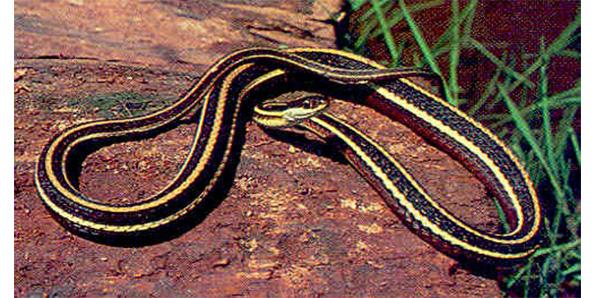
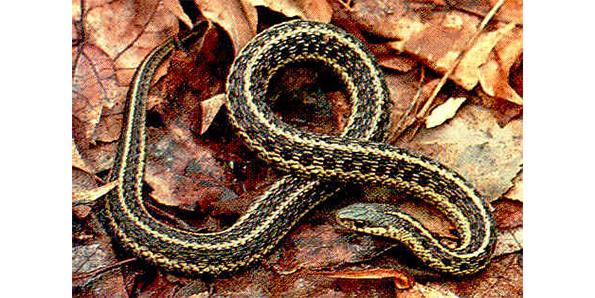
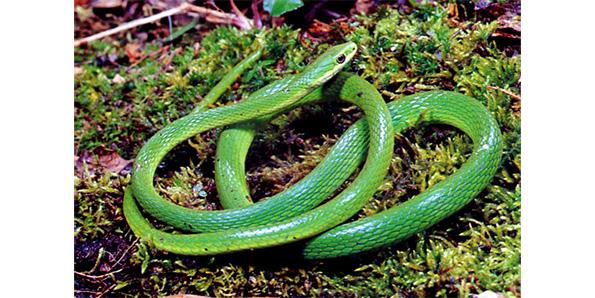
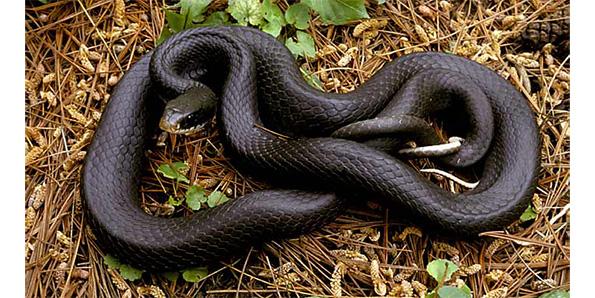
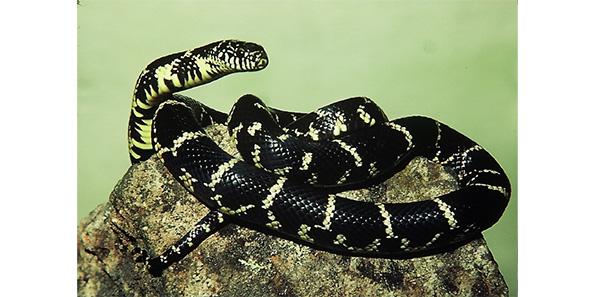
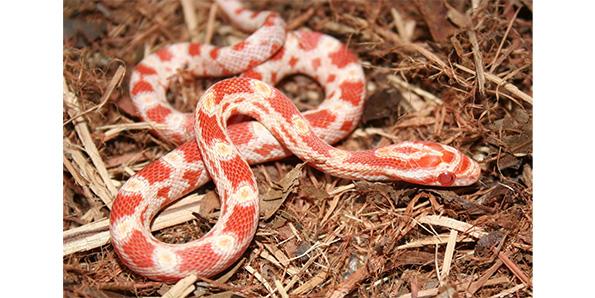
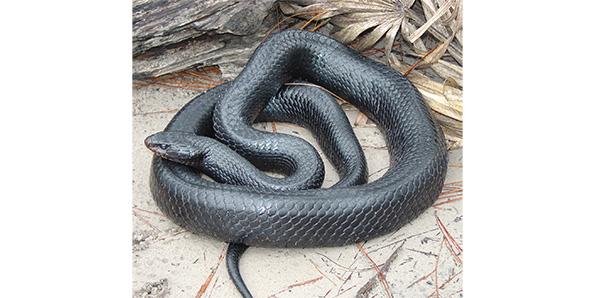
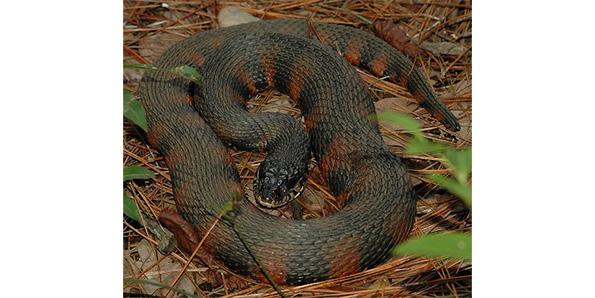
Leave a Reply